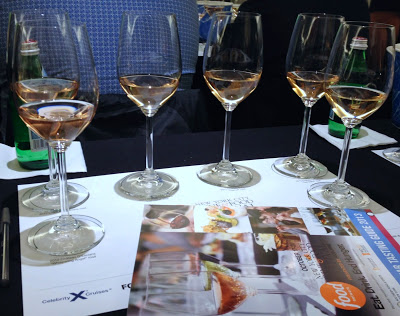
To learn more about Provence rosé and Château d’Esclans, please read my earlier post, “Château d’Esclans’ Garrus Rosé Bedazzles.” I am grateful to Win Rhoades, proprietor of South Street and Vine in Portsmouth, New Hampshire, for his quick lesson in viticulture. Any errors here are not those of Paul Chevalier or Win Rhoades; they are mine (although they may be related to drinking wine while taking notes!)
What could be more fun than sitting in front of six glasses of pale rosé from Provence’s Château d’Esclans? Well, tasting each one with guidance from wine educator Paul Chevalier. That is what my daughter and I were doing last Sunday in New York at the City’s Wine and Food Festival.
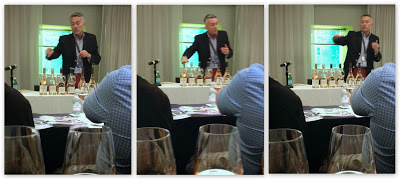 |
| Paul Chevalier. Photo by Susan Manfull |
Everyone in the seminar had fun, judging by the lively conversations and laughter between tastes. However, more importantly, we also learned a lot. Each wine was outstanding, but Chevalier, with his extensive background in viticulture and in winemaking from some of the top…
estates in the world, infused each wine with personality as he explained the details of making each one and how those differences in vinification contributed to the differences we experienced in smell, taste, mouthfeel, and finish. Some contrasts were striking and others so subtle that if he had not brought them to our attention, they would have eluded most people. You could have heard the proverbial pin drop during the tastes as we all endeavored to note the characteristics of the wine that was crossing our respective palates.
Diligent readers of The Modern Trobadors will recall from an earlier post that Château d’Esclans produces four tiers of unique rosé. In ascending order, they are: Whispering Angel, Château d’Esclans, Les Clans, and Garrus.
We would taste the most recent vintages of each wine and, in the case of the latter two rosés (the premiere cuvées), we would have the pleasure of also tasting the previous vintage. Thus, the tasting comprised a horizontal tasting of the four wines: 2012 Whispering Angel; 2012 Château d’Esclans; 2011 Les Clans; and 2011 Garrus; and a vertical tasting that included the latter two rosés and the 2010 vintage of each one. (Because Les Clans and Garrus are aged for about a year, 2011 is the most recent vintage available.) All wines are produced at Château d’Esclans, owned by Sacha Lichine (former owner of Château Prieuré-Lichine 4th Grand Cru in Margaux), under the watchful eye of Patrick Léon (former winemaker for Château Mouton-Rothschild, Opus One, and Vina Almaviva). The Château is located in La Motte-en-Provence in the Var Department of Provence (AOC Côtes de Provence).
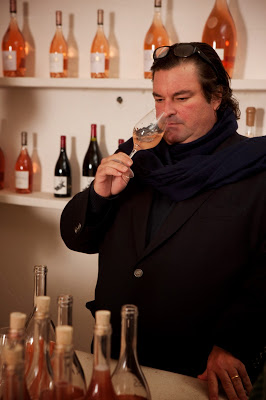 |
| Sacha Lichine. Photo courtesy of Château d’Esclans |
My daughter was already familiar with Whispering Angel and, in fact, had raved about it. Many young people in New York know Whispering Angel because it is one of the City’s most popular by-the-glass rosés served in top clubs and restaurants. It is immensely popular in the Hamptons, where it is sometimes referred to as that area’s “drinking water.” I hasten to say that Whispering Angel, although the Château’s entry-level rosé, is popular among all age groups. (In our earlier tasting—including some folks over 50 years old—it was a huge hit!) It was even featured in an episode of an NBC television series, “Up All Night.”
I was familiar with the most recent vintage of each wine, but had not tried them all side by side. I was particularly excited to do this because, as you can see in the chart below, the grape varietals of each wine are basically the same (exactly the same in the case of the top three wines) and the percentages of each of the grapes are about the same (exactly the same in the case of the premiere cuvées).
In this horizontal tasting we would be able to examine the combined effects of five factors on (basically) two grapes. The factors are: age of the vines, elevation, soil, vinification, and aging. (See the chart below for the specific differences among the wines.) In the vertical tasting, we could examine the effects of aging the wine for a year (although, of course, there are myriad factors—mainly related to weather—that may affect each harvest).
| Whispering Angel (2012) $20 |
Château d’Esclans (2012) $35 |
Les Clans (2010 & 2011) $55-$65 |
Garrus (2010 & 2011) $90-$95 |
|
|---|---|---|---|---|
| Grape Varieties | 72% Grenache, 13.1% Rolle, 4.3% Cinsault, 7.1% Syrah, 3.5% Tibouren |
85% Grenache, 15% Rolle | 80% Grenache, 20% Rolle | 80% Grenache, 20% Rolle |
| Age of Vines | 10-12 years | 20-25 years | 50-55 years | 80+ years |
| Elevation | Lower | Mid | Upper | High |
| Soil | Clay and Gravel | Clay and Limestone | Rocky, Limestone and Gravel | Very Rocky and Limestone |
| Vinification | 100% Stainless Steel Fermentation Tanks | 50% Stainless Steel Fermentation Tanks and 50% French Oak Barrels | 100% French Oak Barrels (50% new oak and 50% one-year old oak) | 100% French Oak Barrels (all new) |
| Aging | 3-4 months | 6 months | 11-12 months | 11-12 months |
| Alcohol Content (ABV) |
13.5% | 13.5% | 13.5% | 13.5% |
Maybe I am a researcher at heart. I honed these skills early on, as an undergraduate in methods classes and as a research assistant to a professor who lived and breathed experimental psychology (especially in his lab of white rats, runways, and various sizes of reinforcement). The only saving grace at the time was that I garnered a reputation (and a tidy sum of money) tutoring other psychology majors for whom isolating a variable, while holding all others constant, to study its effects….well, the concept didn’t come naturally and certainly didn’t excite them. Later, I would find that having the scientific method firmly etched into my brain was helpful in graduate school and, still later, in just about any arena in which you want to understand something. But, I’ve diverged…what does this have to do with tasting wine?
I love to drink wine but I really love to understand it. Why, for example, does the same variety of grape taste so different from one region to the next or even from one estate to the next in the same region? Take the ubiquitous Sauvignon Blanc, for example. The wine produced from this grape tastes noticeably different from one side of the Loire River to the other (Pouilly-Fumé vs. Sancerre) and very different from that produced in New Zealand, California, or South Africa. I love a tasting that helps me discern those differences and to understand why they may be there.
That is exactly what my daughter and I—and a room full of other people—did when we attended the Château d’Esclans rosé tasting, hosted by Paul Chevalier and Sacha Lichine. Billed as a “Celebrity Cruises Wine Seminar” and hosted by Food & Wine, this wine tasting was exactly the kind I love. Methodical and lots of fun.
Lichine wasn’t able to attend but Chevalier—former winemaker, current educator and National Fine Wine Director with Shaw-Ross International Importers—took control of the stage with great finesse and tremendous depth of knowledge. Armed with a perfect balance of humor and fact, he guided us through the tasting of the estate’s four different rosés produced from the same (basic) grape varietals but differing in several other significant ways.
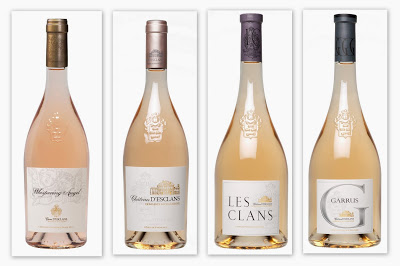 |
| The full line of rosés from Château d’Esclans. Photos courtesy of Château d’Esclans |
As Chevalier put it, he would walk us up the hill as we tasted the first four wines, beginning at the lowest elevation where the grapes for Whispering Angel are grown and ending at the highest elevation, the top of the hill, named Garrus (the Latin word for “bear,” which was chosen by the Romans because, apparently, the area was once filled with lots of wild bears). As we ascended the hill, the age of the vines increased dramatically and the soil went from clay and gravel to very rocky and limestone. How did these factors manifest themselves in the wine?
As we moved toward the top-tiered Garrus, the vinification process—particularly where the juice was fermented and aged as well as the length of time that the wine was aged—changed radically. How were the wines different as a result?
This methodical approach enabled us tasters to recognize the role that specific factors (mentioned above and detailed in the chart) played in creating the final product, the wine in those six glasses that now begged to be tasted.
Whispering Angel (2012). Although described as the Château’s entry level rosé and comprised of “everything that is not perfect” at the estate, this is an elegant rosé and among my favorites of other similarly priced (and even higher priced) rosés. I would enjoy having a few more bottles in my cellar (and my daughter would be ecstatic!).
 |
| Rosé Barometer. Château d’Esclans handout from the seminar at NYC Wine & Food Festival 2013. |
Its color, usually referred to as “rose petal,” is captivating. To maintain the pale color, the grapes (for Whispering Angel and all of the estate’s wines) are picked ripe and kept cool (with dry ice) from the time they are harvested (hand-picked at dawn, when it is cooler) and throughout the vinification process. Constant cold temperature and minimal contact with oxygen maintains the desired light color (as opposed to turning brown like, say, apples when exposed to air).
The nose, Chevalier and others described as bearing ripe fruit with hints of something floral, and licorice and spice (from the Rolle). The mouthfeel, to me, seemed silky; Chevalier noted that it has some “viscosity” (which I think he said was also due to the Rolle). The taste is so pleasant, so easy that the contents of the bottle will disappear quickly (as we saw in our earlier tasting). Dry, no astringency. The finish is satisfying and surprisingly long.
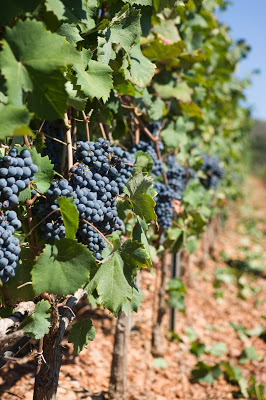 |
| Photo courtesy of Château d’Esclans |
Because the grapes are picked very ripe, according to Chevalier, the wine is smooth, fleshy and dry but without the astringency and bite.
It is a light rosé, not surprisingly, for several reasons. The vines are young, producing twice as many bunches of grapes as the estate’s oldest vines. A higher yield of grapes enables more wine to be produced but the grapes themselves would have much less intense flavor. Any complexity—and to me, there is a surprising amount—probably comes from the additional blending grapes (see chart). To me, it is just what you would like to find in a classic Provence rosé.
Château d’Esclans (2012). This is the Reserve Rosé, one step up from Whispering Angel. We have begun the walk up the hill to a slightly higher elevation where temperatures are slight cooler, the soil has some limestone in it, and the vines from which the grapes come are twice as old as those that provide the grapes for Whispering Angel. To make this wine, only half of the juice is fermented in stainless steel tanks while the other half ferments in demi-muids (600 liter French oak barrels). This wine is aged (in tank and barrel) for six months (about twice as long as Whispering Angel). So you would expect to see a more interesting, complex wine (with a higher price tag)…and you do!
Chevalier pointed out that we see “legs” (which he linked to the glycerol levels, a naturally occurring by-product of alcoholic fermentation) and that the mouthfeel has a slight creaminess (which he explained was due to the introduction of a new variable, oak barrel fermentation of half the wine). He also suggested that we should experience a little “minerality” (due to the presence of limestone in the soil, in contrast to the soil of the vines used for Whispering Angel). I tasted more pronounced fruit (dark berries, to me). Quite different from Whispering Angel. Not as perky, more elegant.
This wine was very appealing to me but it may be interesting to note that my daughter did not initially like this rosé. I think that Château d’Esclans is so different from Whispering Angel and most other rosés from Provence that she was taken aback. When she returned to this wine, later in the tasting, she liked it very much.
Les Clans (2011). To me, this wine is qualitatively different wine from the first two wines we tasted. It is much more complex: richer, more layered, much creamier, and a longer, more interesting finish. Les Clans has aged twice as long as Château d’Esclans (which is why the most recent vintage is 2011—the 2012 is still aging!). The vines from which the grapes were picked are significantly older than the last wines and indeed older than the vines that provide the grapes for almost any other rosé. Having been aged in 100% oak barrels also adds another dimension—increased texture—not as pronounced in the previous rosé (or rosés from almost any other estate). “Unctuous” is the word often used to describe this quality. (Chevalier made clear that the oak barrels are not used to add any oak flavor!).
Wine Spectator described this wine as having “…mouthfilling flavors of dried cherry, currant and ripe pear…flanked by concentrated notes of allspice and dark chocolate.” The review goes on to say “The finish unfolds with layers of candied ginger, pineapple and cream that are unctuous and complex.” The connection between my palate and the language centers of my brain will never be developed enough to produce such a description, but I can say unequivocally that this wine is exceptionally pleasing to my palate (and I will keep tasting in an effort to build the connection!)
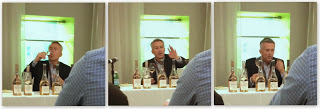 |
| Paul Chevalier. Photo by Susan Manfull |
As Chevalier pointed out, one has the distinct impression that “this is not a rosé.” It is certainly not what we think of as a rosé. Whatever it is, both my daughter and I really liked it.
Garrus (2011). In my earlier TMT post, I discuss our tasting of this wine. Here, second time around for me, this tasting reinforced how much I like this wine. At the risk of exaggerating, it is a veritable explosion of sensation in the mouth and nose.
Remember that Lichine’s goal with Garrus is to produce the best rosé in the world. He starts with grapes harvested from vines that are at least 80 years old and grown in a soil that will bring the best out in these grapes. To put this in perspective, 10-12 bunches of grapes are produced from each of these vines compared to 20-22 bunches from the youngest vines used to make Whispering Angel, making for very concentrated flavors. According to Lichine (in a video-taped interview with James Suckling) with longer roots that run deeper into the soil and through layers of the rocky limestone soil, searching for water and food, the upshot will be increased minerality, flavors, tastes, and general complexities in the grapes.
With Garrus, we are tasting wine made from grapes grown at the highest elevation (300 meters). As elevation increases, temperatures become cooler, which makes for sharper acidity and wines that are easier to pair with food. Garrus is particularly versatile in this area.
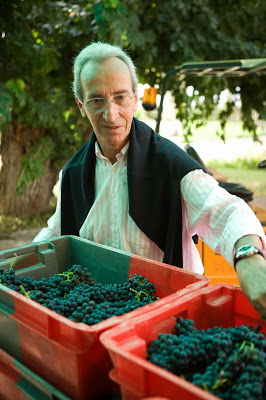 |
| Patrick Léon. Photo courtesy of Château d’Esclans |
Patrick Léon, world-renowned wine maker in both Burgundy and Bordeaux, has years of experience as well as the latest generation equipment. He can employ state-of-the-art procedures from picking the grapes to bottling the wine but, nonetheless, it seems to me that this is a hand-crafted rosé.
If Les Clans doesn’t taste like what we expect rosé to taste like, Garrus really doesn’t seem like a rosé. With one’s eyes closed—or, as Chevalier said, in one of Reidel’s black glasses—no one would guess this was a rosé . I am not alone in saying that it tastes like a buttery white burgundy.
What made this particular tasting so interesting was that having Les Clans and Garrus right next to one another enabled us compare the same grape varietals, in the same proportions and aged for the same length of time, but differing in terms of age of vines, elevation, soil and proportion of new oak barrels. In comparison to the other two wines, the color of Les Clans and Garrus is much paler (due, as I understand it, to the long aging in oak). It is striking how so much flavor can be derived from those grapes—Grenache is a very dark “inky” grape—and how pale the color of wine is. The Garrus was better, but the differences were nuanced: more layers of flavors and a perfect feel (which, I think, means a perfect balance of acidity and fruit). As I wrote in the earlier post, I found it bedazzling. (But, I want to note that I would be very happy with a bottle of Les Clans, too!)
The last two wines we tasted were the two earlier vintages of Les Clans and Garrus. Unlike almost all other rosés, these two rosés can benefit from aging. Chevalier said that Les Clans may stay in the cellar for three years and Garrus for four years. (Wine Spectator suggested that the 2011 Garrus could be enjoyed through 2017!) To me, the differences were subtle and, for me, impossible to articulate except perhaps to say that age had mellowed the Garrus. I had a slight preference for the 2010 Les Clans…maybe….oh darn, I need to taste these two again!
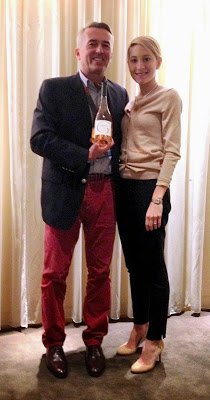 |
| Paul Chevalier. Photo by Susan Manfull |
This was a terrific tasting that, as I said above, was both fun and very informative. It was fascinating to experience—in the nose and the mouth—how the wines changed as we walked up the hill to Garrus. That is, how basically the same two grape varietals can change under different conditions. As my daughter said, “Rosés have much greater depth than I had realized and Paul’s excellent presentation demonstrated how rosés really do have the same potential of complexity as reds and whites.”
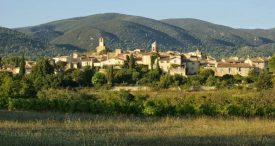





Bedazzling summary Susan. Mitri would be proud of you. Did you do the chart? Looks like I'll have to get over to d'Esclans and take some pics. Perhaps they'll let me taste if I drop Alex's name.
p.s. So jealous that I wasn't there. And, Alex, so jealous that I don't look like you!
Wow – that much have been so much fun for you! And it was incredibly coherent considering the amount of tasting you did! 🙂 My favorite part is the chart of pinks – how fun is that? ~ David
I am sure Mitri Shanab was looking over my shoulder….Let's plan a "Day at the Châteaux" when I am there!
We will have a "re-do" when we are all together!
and David, I wish you would have been there. You would have loved it!
C'est fait!
Je voudrais bien but with Paul Chevalier. Much more illuminating and engaging to have someone intimate with the domain and its viniculture guiding you through, especially with vertical and horizontal tastings, which are more subtle. Date?
Susan,
Your wine related items over the past two issues are truly first rate. Certainly wish I could have been at the table to partake of the Sacha Lichine rose's you tasted in New York recently. As I am decidedly old school, I wonder if you have yield information other than bunches of grapes per vine. I relate better to the time honored French system of hl/ha (hectoliters per hectare). Any way of telling me what the four growing areas are pegged at, i.e. I assume something like 45 hl/ha at the top, and 65-70 hl/ha on the floor.
Regards,
Jerry
Hi Jerry,
Thanks for such positive feedback. I am going to forward your inquiry to Paul Chevalier who will undoubtedly be able to answer right away. It was indeed a terrific tasting and I know you and Benedicte would have loved it!
I think that Paul could develop quite a following!
A day at the Châteaux?
Bientôt…j'espère!
Note to my readers: This post, dated (November 1) was inadvertently placed on the post entitled "The Curious Case of Miraval's Grapes." So, with the commenter's permission, I have posted it here. Best, Susan
this blog was perhaps the most interesting and mouth watering story yet !As a person who prefers rose' wine , and was once looked down their noses by those with more expertise, enjoyed a glass of wine with dinner without really thinking about it until I read the in depth dscription of the four wines. At that time I wish I could taste each one with with my newly educated taste buds and the expertise of a professional. I wish that we could have a real first class wine tasting in Southern Califotnia. Paul Chevalier would be a first choice.
Hi Jerry, I asked Paul about this a while ago and, after established the answer, I forgot to pass it along to you! My apologies. Paul, before I finished my question, knowingly chuckled and acknowledged that most people who know wine prefer the information about which you wondered.
For people who don't know, you are inquiring about how much wine is made per hectare (as is the custom in most of Europe), whereas in North America, the yield is measured by grapes per acre/ hectare. Paul said that Whispering Angel (on the floor) is 55-60 and Garrus (at the top) is about 35-40. By comparison, Dom Perignon yields are similar to Whispering Angel (i.e., very profitable). Paul said that very few estates have such low yields.
Thanks so much for your question–Sacha Lichine will be hosting the same tasting in Boston in February (15-16) at the Wine Expo. If memory serves me correctly, it is $35–well worth the price!
Re a tasting with Paul Chevalier, he said that he will be at the South Beach Wine and Food Festival on February 23rd. It looks like the event runs from the 20th to the 23rd.
Sacha Lichine will be hosting the same wine tasting (as I attended in NYC) in Boston in February on the 15th!
We are still hoping he will be up in Portsmouth, once it thaws.
Here is the information about the same tasting–but with Sacha Lichine–in Boston at the Wine Expo on February 15th.
11:00 AM – 12:00 PM
Chateau d'Esclan – Sacha Lichine
$35
Join Sacha Lichine, the son of influential wine writer, wine merchant and Bordeaux Chateau owner, Alexis Lichine, for the Rose tasting of your life! Sacha, who attended college in Boston, will be presenting his Provencal wines from Chateau d'Esclans. While dry rose wines have returned to fashion in the U.S., they have long been the wine of choice on the dining tables of southern France. D'Eslcans has a notably talented winemaker in Patrick Leon. Leon directed winemaking at first growth, Chateau Mouton-Rothschild and associated Chateaux and consulted on Opus One and Almaviva. He is in charge of the cellars at d'Esclans and produces four unique roses there: Chateau d'Esclans Rose, 'Whispering Angel' Rose, 'Les Clans' Rose, and the highly regarded 'Garrus' Rose, a limited production wine that has been referred to as 'the best Rose on earth'. Don't miss this unique opportunity to welcome Sacha back to our fair city and taste the fruits of his labors in this lovely corner of southern France.
Wines:
2013 Château D'Esclans "Whispering Angel" rosé
2012 Château D'Esclans rosé
2011 Château D'Esclans "Les Clans" rosé
2011 Château D'Esclans "Garrus" rosé
2010 Château D'Esclans "Les Clans" rosé
2010 Château D'Esclans "Garrus" rosé
I asked Paul if there would be any tastings on the west coast–it seems that Austin might be the furthest west. Darn! But, you could have fun tasting them with a small group of people…although tasting the wines with such expertise is a real learning experience (and fun!).